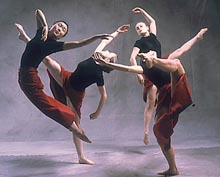
Toronto Dance Theatre, recently at the Joyce for a week, was founded 30 years ago as a scions-of-Martha Graham company. Subsequently, under the direction of Christopher House, who began choreographing for the group in 1981, its repertory has shifted from heated passions to cooler ones, from the fraught, subjective worldview that prevailed in the era of the troupe’s emergence to a more distanced, impassive attitude. This ability to evolve with the times and changing taste has no doubt contributed to TDT’s survival. Never having harbored a choreographer of genius, it pleases by being professional and timely. The program offered in New York was agreeable, even admirable for its general competence, disappointing if you were after a radical aesthetic experience – the kind that jolts you, stirs you, enlarges the scope of your imagination.
The most “important” dance on the program was House’s Fjeld (the Norwegian title means barren plateau). The Arvo Pärt score does much to support the atmosphere of the bleakness and stubborn endurance that can follow catastrophic tragedy. House is on record as saying the work was inspired by the Old Testament. To me, it was brother to the many, many dances that have been made about the Holocaust, Hiroshima, and, more recently, aids. It would be a better work, I think, with more action and less emphasis on self-consciously stark, handsome images.
Schubert Dances, a solo created by House, which I had the luck to see him perform, offered the most engaging and idiosyncratic movement. At 43, House is still a splendid dancer: alert, quick, and light, with a frank, offhand demeanor. Coupled with deceptively man-in-the-street-ish choreography, this aura of ordinariness enchants and, of course, eventually calls attention to the beauty present in life’s endless stream of casual events.
The single work on the program that I found original and riveting was James Kudelka’s Provincial Suite (set to Darius Milhaud’s Suite provençale). A quintet of men and women are costumed in Jane Townsend’s delicious take on regional female-peasant garb, with wildly daubed makeup and fantastically dressed hair. Their movements are raucous and bizarre, yet they (raggedly) follow a formal pattern and respond viscerally to the music. The cavorters are clearly a community – with idiosyncratic and complex individual personalities – and they are clearly performing ancient festival rituals. But Kudelka makes us see them as Mme. de Sévigné might have on a visit to her daughter in Provence – as a highly cultivated person from an aristocratic Parisian milieu encountering the enigma of the primal. Apparently Kudelka, a respected, prolific choreographer and head of the National Ballet of Canada, meant the piece as a takeoff on the folkloric-style dances that were inevitably injected into nineteenth-century ballets. But it is far less funny than a simple spoof would be, far stranger, and far more profound.
TDT’s current performers – a dozen, not counting House – are unquestionably proficient (high technical skill is almost a given these days); a few are interesting as well. Naoko Murakoshi, stockily built and sudden in her movement impulses, caught my eye, as did the former gymnast Sasha Ivanochko, with her potential for drama. The most gorgeous person onstage was Graham McKelvie, who combines the look of a wild animal in repose before a critical lunge with that of a lush exotic flower.